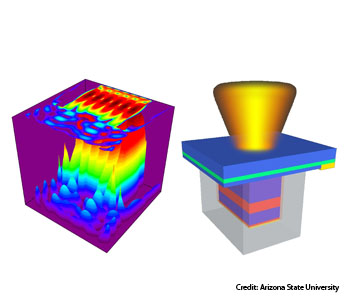
Left: Numerical simulation of light intensity variations within a nanolaser. Right: Schematic of a nanolaser with a metallic cavity. The red center confines electrons and the grey enclosure is a silver cavity. The top blue layer is a substrate where the laser structure is grown. The orange-yellow color on top indicates the light emission.
Researchers based in the United States have built a continuous-wave laser that is shorter than its telecom-scale operating wavelength—and it works at room temperature (Opt. Express 21, 4728).
According to Cun-Zheng Ning, an electrical engineering professor at Arizona State University, the nanolaser is the first device of its kind to meet four criteria: continuous-wave operation, electrical pumping, subwavelength size and room-temperature operation. Previous nanolasers met two or three of these criteria, but not all four.
One of the biggest challenges for this research team lay in the precise fabrication of the device, Ning says. The scientists built the tiny laser’s core out of a sandwich of indium gallium arsenide and indium phosphide, with an insulating layer of silicon nitride and a cavity shell of silver. They used hydrogen silsesquioxane, rather than the usual acrylic, as the resist in the electron-beam lithography process to smooth the edges on the semiconductor pillar. Any fabrication error in such a small device would render it non-operational, according to Ning.
The dimensions of the nanolaser’s optical cavity are 1.15 × 1.39 × 1.7 µm. Since the nanolaser operates at 1,591 nm, it has a cavity volume of 67 percent of the “cubic wavelength.” At 294 K, the device exhibited a linewidth of 0.5 nm and a Q-value of 3,182. Although the nanolaser cannot compete with sophisticated distributed-feedback lasers in large-scale telecommunications systems, it could be an important building block in future chip-scale nanophotonic devices.
Next, Ning and his colleagues will try to improve the nanolaser’s lifetime and efficiency. They will also explore the fundamental size limit of such tiny devices.
The nanolaser research grew out of a U.S. Defense Advanced Research Project Agency challenge to build subwavelength lasers, says Ning, who began the work while at NASA Ames Research Center in California 7 years ago. In addition to his students, especially Kang Ding, two researchers from the Eindhoven University of Technology in the Netherlands also participated in the experiments.
